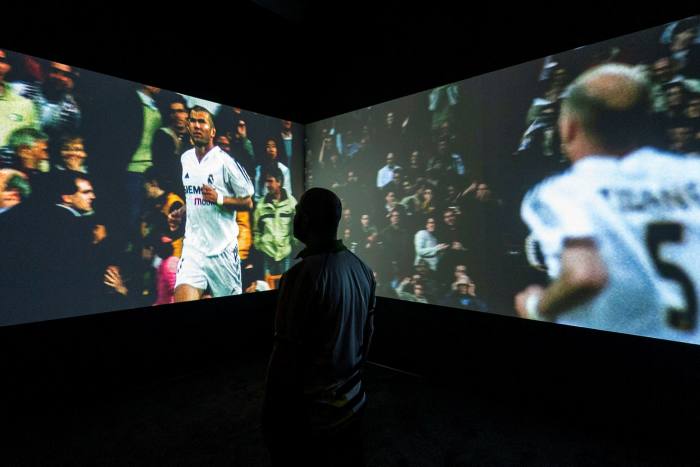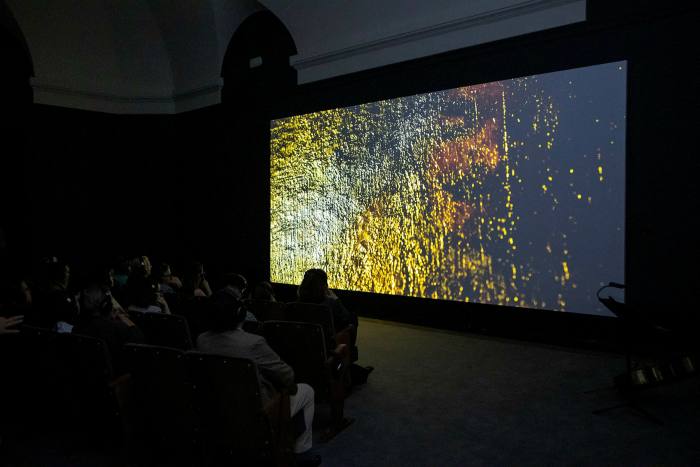Cosmic forces appear to be unleashed in the opening minutes of “La Quinta del Sordo”, a new film by the French artist Philippe Parreno now showing at the Prado Museum in Madrid. Amid an ominous ambient soundtrack, played through headphones, planets and stars appear to be on the move. A sinister organic form — is it a giant, sun-devouring creature? — comes out of the darkness. Specks of light flicker across the screen in super-slow-motion, and seem to explode.
And then, abruptly, the camera pans across to the true subject of Parreno’s film, the famous “Black Paintings” of Spanish master Francisco Goya. (The auditorium is in a room next to the paintings themselves.) We see one of the best-known figures from the series: a witch, captured in three-quarter profile, who turns away with a terrified expression from something she has witnessed. The camera continues to nudge its way across the painting, focusing on the remaining wild faces in the crowd in extreme, disorienting close-up.
“La Quinta del Sordo” (“The Deaf Man’s Place”) is named after Goya’s country house just outside Madrid, to which the artist, who had himself lost his hearing, retreated in 1819, at the height of his fame. Soon after moving in, Goya started on his disturbing and mysterious late works, painted in oils directly on to the walls. The motivation and precise intentions behind the 14 Black Paintings remain obscure, but they are among the Prado’s most visited works, and their brutal subject matter has caused them to be regarded as an eccentric prefiguration of modern art.
“I was inspired by the darkness of it when I was a teenager,” says Parreno when we meet in Madrid. “They were a little bit occult, a little bit weird. They were incomplete, in a way, which was a big part of the attraction.”

Parreno is today lauded as one of the most original and cerebral of contemporary artists whose best-known work, the 2006 film Zidane: a 21st Century Portrait (co-directed with Douglas Gordon), on the French footballer Zinedine Zidane, continues to enrapture art-loving audiences, and a few football fans too, around the world. But his teenage engagement with the Old Master remained tucked away inside his head.
His 40-minute film on Goya is, like Zidane, a technical tour de force. While the portrait of the sporting legend used 17 cameras to follow his every movement during the course of a match, Parreno this time focuses his lens on the stillest of subjects, recording in infinitesimal detail the surfaces of Goya’s bleak paintings.


When I ask him about the film’s spacey opening, he brings me down to earth. The “planets” and “stars” are in fact ashes, floating from a piece of burnt wood, used to recreate the atmosphere of Goya’s workplace. The speed of the camera — 500,000 frames a second — seems to stop time, and means that nothing appears normal or familiar. “It freezes the moment,” Parreno says. I forget to ask him about the sun-eating monster; it could be the hind leg of a flea.
Parreno confesses that “La Quinta del Sordo” is a “complex” work. It was conceived as a coda to a 2021 exhibition on Goya held at Basel’s Beyeler Foundation. His first thought was to recreate Goya’s house, which was demolished in 1909, well after the removal of the paintings, in a 3D display. “But I quickly understood that was going to be a bit crap,” he says disarmingly.

Instead, using high-resolution technology, he aimed to “film the space between the paintings”, creating a kind of dialogue between the works. “We knew where the paintings were, and which of them faced each other.” Rather than discard the 3D model of the house, which he had created for his original plan, Parreno used it to form an acoustic profile of its spaces and corridors, and also of the paintings themselves. “The Prado gave us 3D scans of the paintings, and we ‘recorded’ the textures of the paint, like a needle on vinyl,” he says, giving some idea of the sense-scrambling aspiration of his work. “In a way, the painting is talking to you.”
Parreno describes the three nights of shooting at the Prado as “insane”. “There we were with the paintings, listening to some weird soundtrack, getting really, really high,” he says. “There were characters [in the paintings] that I had never really seen before — this weird clown . . . they are all shouting, but you cannot hear them. As if they had taken their last breaths.”
I ask if he came closer to understanding Goya’s state of mind when working on the Black Paintings. “He seemed to be possessed. This guy, he painted in chapels and cathedrals. He painted kings and priests. And then he comes to this house and paints graffiti: he painted directly on to the wall, not frescoes. He never meant the paintings to be there without the house being there.”


The preoccupation with space is a frequent theme in Parreno’s work, and has led to some startling reconfigurations of prestigious cultural institutions such as Tate Modern in London and the Palais de Tokyo in Paris. In a commission for New York’s Museum of Modern Art, his installation “Echo” comprised a multi-part automaton moving around the museum in response to live data taken from its surroundings.
He says he conceives some of his works as “biomechanical creatures”, bringing life into institutions that are largely composed of dead people’s works. “They are quasi-sentient,” he says. But you are their creator, I say. He corrects me: “I am the creator of a milieu in which things can develop without me being around.”
He aims to recreate something of that spirit in the Goya film — not so much bringing old paintings to life as allowing the space in which they were created to assert its ghostly, occult presence. He points to another influence on his work, produced contemporaneously with the Black Paintings: Mary Shelley’s Frankenstein, published in 1818.
Parreno has been working on a film of the novel and finds inspiration in its central theme: “The monster has a dilemma: how can you be, without being born? It is a beautiful line, and it makes you think about the debate today over artificial intelligence. And then also at that time, you had this extreme weather. There was a brutal heatwave [in 1818] in which many crops died. And they talked about climate change.”
There is an ominous subtext to his words, which he gently spells out. “It is a period which has quite a lot of parallels with the times in which we live.”
Prado Museum, Madrid, to September 4, museodelprado.es
Stay connected with us on social media platform for instant update click here to join our Twitter, & Facebook
We are now on Telegram. Click here to join our channel (@TechiUpdate) and stay updated with the latest Technology headlines.
For all the latest Art-Culture News Click Here
